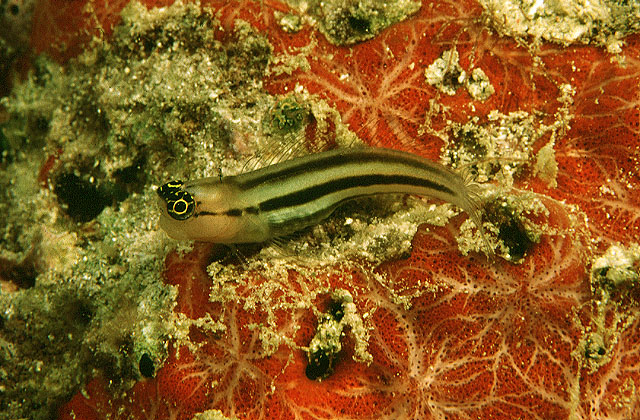| Blenniidae (Combtooth blennies), subfamily: Salariinae |
| 3.95 cm SL (male/unsexed) |
|
reef-associated; marine; depth range 1 - 10 m |
| Western Pacific: Papua New Guinea and the Solomons. |
|
Dorsal spines (total): 12-13; Dorsal soft rays (total): 13-15; Anal spines: 2-2; Anal soft rays: 15-17; Vertebrae: 31-33. Description: Dorsal fin XII (rarely XIII),13-15 (usually 14), with deep notch between spinous and ray portions; anal fin II,15-17; pectoral rays 12-14 (usually 13); pelvic fin I, 3; caudal-fin segmented rays 13. Body depth 4.9-5.4 in SL at anal-fin origin. Vertebrae 10 + 21-23 (usually 22); incisors and anterior canine teeth look very similar, 41-49; posterior canines 1 on each side, sometimes absent. Lateral line without pores, ends below dorsal spine 9-10. Anterior nostril with cirrus present only on posterior rim. Overall pale grey or dusky brown, ventral paler, with dorsal and ventral dark stripes narrowly spaced. Eyes with narrow yellow ring around the pupil and yellow streaks on iris. Interorbital region with bilaterally paired spots and sometimes a median spot. Dark stripe from eyes to posterior edge of operculum continuous with the ventral dark stripe on body. Dorsal-fin ray portion with suprabasal stripe, fine and dusky; anal fin dusky but pale distally in some mature males; caudal fin dusky with basal half-moon mark (Ref. 5296, 90102). |
| Adults are found in loose small groups or solitary, usually in sheltered lagoon reefs at depths of 1-10 m (Ref. 90102). Oviparous. Eggs are demersal and adhesive (Ref. 205), and are attached to the substrate via a filamentous, adhesive pad or pedestal (Ref. 94114). Larvae are planktonic, often found in shallow, coastal waters (Ref. 94114). |
|
Least Concern (LC); Date assessed: 25 March 2009 Ref. (130435)
|
| harmless |
Source and more info: www.fishbase.org. For personal, classroom, and other internal use only. Not for publication.

